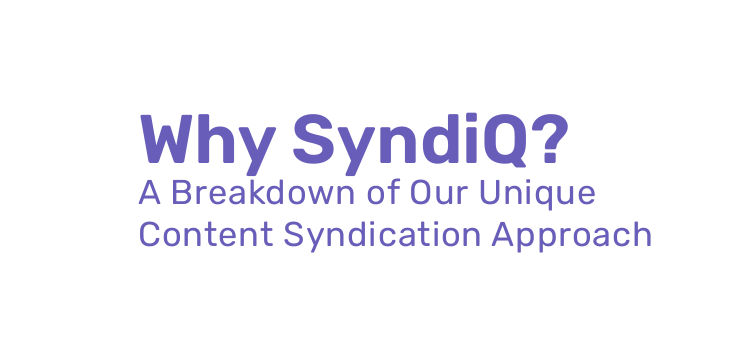Content syndication has become a crucial element in digital marketing strategies for businesses seeking to expand their reach and generate qualified leads. However, as with any powerful marketing tool, misconceptions and challenges often arise that can hinder its effectiveness. At SyndiQ.io, we have made it our mission to provide top-tier content syndication services, leveraging advanced AI to overcome these obstacles and dispel common myths. In this blog, we'll dive into some of the most prevalent challenges and myths surrounding content syndication and how you can address them.
Myth 1: Content Syndication Hurts SEO
One of the most common myths surrounding content syndication is the fear that republishing content on multiple platforms will negatively impact SEO rankings. This concern is rooted in the idea that search engines penalize duplicate content, which can lead to lower rankings.
The Truth: Search engines like Google are smarter than ever. They can identify syndicated content and distinguish it from spam or malicious duplicate content. As long as the syndicated content includes proper canonical tags or backlinks to the original post, SEO rankings won't be affected. In fact, syndication can boost SEO by driving more traffic to the original source. At SyndiQ.io, we ensure that our clients’ syndicated content is optimized for search engines, prioritizing quality over quantity.
Myth 2: Syndicated Leads Are Low Quality
Another common misconception is that leads generated through content syndication are less valuable or lower quality compared to other lead generation strategies. Many marketers fear that these leads are just casual readers with no genuine intent to convert.
The Truth: Not all syndicated leads are created equal, but with the right tools and strategies in place, lead quality can be significantly improved. At SyndiQ.io, we use AI-driven lead scoring and tiered lead segmentation to filter and categorize leads based on engagement levels. Our system ensures that businesses receive highly qualified leads with a higher likelihood of conversion, eliminating the worry of low-quality prospects.
Challenge 1: Managing Content Across Multiple Platforms
One of the challenges marketers face in content syndication is managing the distribution of content across various platforms. Ensuring consistency, maintaining brand voice, and avoiding duplication can be difficult when content is published on multiple sites.
The Solution: The key to overcoming this challenge lies in proper planning and leveraging technology. Automation tools can help streamline the process of content distribution, ensuring consistency across all channels. SyndiQ.io's platform offers real-time engagement tracking, allowing businesses to monitor how their content is performing across different platforms and make adjustments as needed. This level of visibility ensures that content remains aligned with brand standards while reaching the widest possible audience.
Myth 3: Content Syndication Is Only for Large Enterprises
There’s a misconception that content syndication is only effective or accessible for large enterprises with big budgets. Smaller businesses often feel like they can’t compete in this space or afford to implement content syndication strategies.
The Truth: Content syndication is not exclusive to big businesses. In fact, small and medium-sized businesses can benefit greatly from syndication as it allows them to expand their reach without the need for a massive marketing budget. At SyndiQ.io, our scalable solutions are designed to suit businesses of all sizes. By using AI to focus on lead quality and engagement, even smaller organizations can see substantial returns on investment.
Challenge 2: Measuring ROI from Syndicated Content
Many businesses struggle to accurately measure the ROI from their content syndication efforts. Without clear metrics, it’s challenging to understand whether the time and resources invested are yielding meaningful results.
The Solution: Tracking the right metrics is essential for understanding the performance of syndicated content. SyndiQ.io's AI-driven solutions help businesses track engagement metrics in real-time, offering insights into how leads interact with content. By categorizing leads into different engagement tiers, businesses can focus their efforts on the most promising prospects, ensuring that they get the best possible return on their investment.
Myth 4: Syndication Dilutes Brand Authority
Some businesses fear that by sharing content on third-party platforms, they might lose control over their brand messaging or that their content might not receive the recognition it deserves.
The Truth: Syndication, when done right, can actually enhance brand authority. It allows businesses to share their expertise with a broader audience while maintaining control over the original content. When properly attributed, syndicated content can increase brand visibility and credibility. At SyndiQ.io, we ensure that all syndicated content maintains a clear connection to the original source, helping to strengthen brand recognition while expanding reach.
Conclusion
Content syndication is a powerful strategy for driving lead generation and expanding brand visibility, but it’s important to navigate the common challenges and myths that come with it. By using advanced tools like AI-driven lead scoring, tiered segmentation, and real-time engagement tracking, SyndiQ.io helps businesses overcome these obstacles and achieve greater success in their marketing efforts.
If you’re ready to take your content syndication to the next level, contact SyndiQ.io and discover how we can help you generate high-quality leads that convert.




